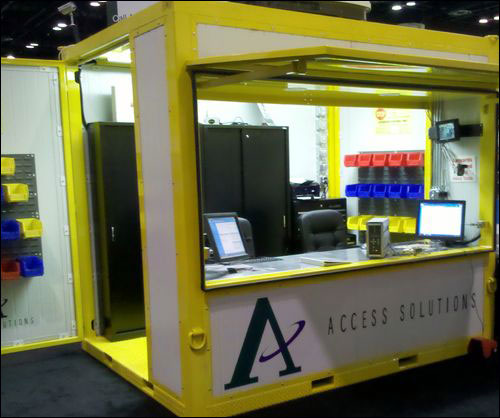Jan 06, 2011After completing tests of a radio frequency identification system at two nuclear power plants, Oregon company Access Solutions has made its RFID-based Cube available for use in tracking tools, materials and personnel into and out of controlled areas at power-generation facilities. The self-contained turnkey structure can be installed at a site and used to manage the flow of individuals and tools into and out of an area controlled for foreign material exclusion (FME), or for clean conditions.
Since 2005, Access Solutions has provided its FME services to power-generating companies to track which personnel enter and exit a controlled zone, as well as any tools (such as wrenches, pliers or electronic equipment) they bring into and out of the area. Not only does Access Solutions' on-site staff confirm each worker's identity, they also assign lanyards and tethers to that individual, to hold tools in place (thereby ensuring the tools do not drop and break or get lost). In addition, they inspect each tool as it enters and leaves the area, to confirm that no small pieces are left behind. The staff also confirms that no one inadvertently carries foreign material adhered to the bottom of their shoes, and that they have no loose items—such as change in their pockets, jewelry or chewing gum—that could cause a problem for the functioning of machinery within the controlled zone.
The process, however, was a manual one. Therefore, in 2008, the company began looking into employing RFID technology to capture data regarding each person and tool entering and leaving the area, thereby allowing the recording of more accurate data, and making the check-in and check-out procedure faster, says Eric Bergstrom, Access Solutions' director. The firm began piloting its RFID-enabled version of its FME service at two unnamed American nuclear power plants, in order to confirm that radio frequency identification could be employed to effectively track the traffic of tools and personnel. At the two participating power plants, Access Solutions attached Xerafy EPC Gen 2 passive ultrahigh-frequency (UHF) RFID tags either directly to tools, or to embedded nylon tethers joined to those tools. Access Solutions' personnel then utilized Motorola RFID readers and S3Edge Spotlight software to capture and store information about the movement of the tools and personnel. Access Solutions also utilizes a variety of other standard UHF tags in addition to Xerafy tags, for situations in which durability is not necessary.
In 2010, based on the experience acquired during those pilots, the company developed the Cube. A steel frame structure insulated against weather and sound, and measuring 8 feet by 8 feet by 9 feet in size, the Cube is designed to function as a self-contained, mobile and fully automated FME center.
The Cube enables Access Solutions to provide RFID-enabled FME service almost immediately, without requiring a power plant to set up an area with furniture and other infrastructure, as it would otherwise need to do in order to accommodate FME personnel and the services they provide. To ensure the RFID technology's functionality under rugged conditions, Bergstrom says, Access Solutions modified the hardware, though he declines to describe what the proprietary modifications consisted of.
Facility personnel are also provided with several lanyards that can be attached to a belt or wristband. The tool tethers are then clipped to that lanyard, thereby ensuring that if a worker drops a tool, it will not fall far. This safety precaution can be important in an environment in which employees may be working on the top of a turbine or generator, in which a tool could fall many feet and get lost or break into small pieces. Each lanyard is fitted with its own EPC Gen 2 RFID tag, the ID number of which is linked to the ID of the individual to whom that lanyard has been assigned.
Upon arriving at the entrance to a controlled area, workers stop at the Cube, located next to that entrance, in order to check in and hand over personal items (such as jewelry, wallets and cell phones) for storage in cubbies within the Cube. Each individual then receives tethers and lanyards, as well as an ID badge, assuming he or she has not already been provided with one.
A Motorola FX7400 fixed RFID interrogator, wired to a Convergence Systems Ltd. (CSL) antenna installed at the counter, captures the ID numbers of the tools, tethers and lanyards as they are placed on or located near the counter. For sites where workers are not issued ID badge, an RFID tag can be attached to each individual's hardhat. The tags' ID numbers are then captured, linked to data about the tools, and stored in the software.
Whether a tag is attached directly to the tool, or to a tether attached to that item, its ID number is linked to information regarding that tool in the software, along with a picture of it. In that way, as each tag is read at the FME station, Access Solutions' staff members seated within the Cube can view a photograph of the tool on a touch screen computer with either a wired or wireless connection to the reader, and can easily determine whether it is the appropriate tool, and whether there are any missing pieces.
If a worker leaves without all the tools that person brought to the site, the software is designed to indicate which items are missing when his or her badge and tools are read at the Cube or FME site. If someone takes a tool off-site that was assigned to a coworker, that action is also indicated by the software at the time that the badge and tools are read, and the coworker assigned that tool is informed, upon exiting, that the item was removed, and by whom. At that point, the coworker can then indicate whether permission was given to take the tool.
Access Solutions' staff must still visually inspect each tool as well, to be sure that no pieces are missing. By using RFID, however, the process of monitoring which tools are carried into or out of the zone, and in whose custody, is now automated. That, Bergstrom says, means a check-in procedure that, for example, previously required three to 15 minutes per person now requires only 30 seconds to three minutes. On average, he estimates, the processing time is reduced by 83 percent.
The Cube, which the company displayed last month at the Power-Gen International (PGI) 2011 conference, will increase efficiency further, Bergstrom says, because it comes with all equipment necessary to launch and run an FME service. While customers needed to supply Access Solutions with tables and chairs in the past, and an RFID reader then had to be set up on those tables, the Cube is now simply delivered to the site by crane (for outdoor use) or towed into an indoor location. It comes with heating, ventilating and air conditioning (HVAC), as well as lighting, and has one or more RFID readers (depending on each end user's particular needs) that can be used on a counter top, or the reader's antenna can mounted to the Cube in such a way as to facilitate the reading of RFID tags attached to hardhats.
Since the PGI conference, Bergstrom says, Access Solutions has been in discussion with potential customers in the United States, Saudi Arabia, South Africa and several South American countries. In some cases, he notes, customers could include oil and gas companies, as well as power plants. The technology could also be employed for servicing wind turbines.



